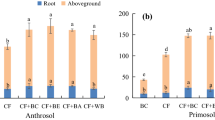Abstract
Wood ash is a residual material produced during biomass burning. In the northeastern United States up to 80 % of the ash is spread on agricultural lands as a liming amendment with the remainder being disposed of in landfills. As well as raising soil pH, wood ash also adds plant nutrients to soil. This study is an examination of the plant availability of the P in 8 different soils amended with one wood ash. Plant availability was assessed by measuring the biomass and P concentration of corn (Zea mays) L.) plants grown in the greenhouse for 28 d in soil amended with either CaCO3 (control), wood ash to supply 200 mg kg−1 total P, or monocalcium phosphate (MCP) to supply 200 mg kg−1 total P and CaCO3. Both corn growth and P uptake were highest in the MCP treatments, intermediate in the wood ash treatments, and lowest in the controls for all soil types. The soil property which seemed to have the greatest influence on P availability was pH buffer capacity. The soils with the greatest capacity to buffer OH additions also tended to exhibit the greatest absolute P uptake from wood ash-amended soils and the greatest P uptake relative to that from MCP-amended soils. The ability of soil test extractants to predict uptake of P in the three soil treatments was examined. A buffered ammonium acetate extradant overestimated P availability in the ash-amended soils relative to the MCP-amended soils. An unbuffered, acid, fluoride-containing extract provided a measure of P levels that was consistent with P uptake from all soil treatments. In this study the predictive relationship was as follows: P uptake = 0.017× (Bray P, mg kg−1) + 1.19; r = 0.81.
Similar content being viewed by others
References
Adriano, D. C., Woodford, T. A., and Ciravolo, T. G.: 1978, J. Environ. Qual. 7, 416.
Armiger, W. H. and Fried, M.: 1957, Soil Sci. Soc. Am. Proc. 21, 183.
Bache, B. W. and Williams, E. G.: 1971, J. Soil Sci. 22, 289.
Barnhisel, R. and Bertsch, P. M.: 1982, ‘Aluminum’, in A. L. Page, R. H. Miller, and D. R. Keeney (eds.), Methods of Soil Analysis, Part 2. Chemical and Microbiological Properties, (2nd ed.) American Society of Agronomy, Madison, WI., U.S.A. pp. 275–300.
Campbell, A. G.: 1990, Tappi J. 73, 141.
Erich, M. S.: 1991, J. Environ. Qual. 20, 576.
Gee, G. N. and Bauder, J. W.: 1982, ‘Particle-size analysis’, in A. Klute (ed.), Methods of Soil Analysis Part I Physical and Mineralogical Methods, (2nd ed.) American Society of Agronomy. Madison, WI, U.S.A. pp. 383–412.
Gilliam, J. W., Logan, T. J., and Broadbent, F. E.: 1985, ‘Fertilizer Use in Relation to the Environment’, in O.P. Engelstad (ed.), Fertilizer Technology and Use, Soil Sci. Soc. Am., Madison, WI, U.S.A., pp. 561–588.
Glenn, R. C. and Hoskins, B. R.: 1989, Soil Testing Handbook for Professional Agriculturalists, 2nd. ed. University of Maine Cooperative Extension. Orono, ME.
Hartikainen, H.: 1984, J. Agr. Sci. Fin. 56, 291.
James, B. R. and Riha, S. J.: 1986, J. Environ. Qual.15, 229.
Jordan, C. F.: 1985, Nutrient Cycling in Tropical Forest Ecosystems, John Wiley & Sons. New York. 179 p.
Karlen, D. L., Ellis Jr., R., Whitney, D. A., and Grunes, D. L.: 1978, Agron. J. 70, 918.
Knudsen, D. and Beegle, D.: 1988, ‘Recommended Phosphorus Tests’, in W. C. Dahnke (ed.), Recommended Chemical Soil Test Procedures for the North Central Region, North Central Regional Publ. No. 221, North Dakota State Univ., Fargo, North Dakota, U.S.A. 58105. pp. 12–15.
McLean, E. O.: 1982, ‘Soil pH and Lime Requirement’ in A. L. Page, R. H. Miller, and D. R. Keeney (eds.) Methods of Soil Analysis, Part 2. Chemical and Microbiological Properties. (2nd ed.) American Society of Agronomy, Madison, WI., U.S.A. pp. 199–224.
Moliner, A. M. and Street, J. J.: 1982, Proc. Soil and Crop Sci. Soc. Florida 41, 217.
Mullins, G. L.: 1988, Commun. Soil Sci. Plant Anal. 19, 1509.
Naylor, L. M. and Schmidt, E. J.: 1986, Tappi J. 69, 114.
Nelson, D. W. and Sommers, L. E.: 1982, ‘Total Carbon, Organic Carbon, and Organic Matter’, in A. L. Page, R. H. Miller, and D. R. Keeney (eds.), Methods of Soil Analysis, Part 2. Chemical and Microbiological Properties, (2nd ed.) American Society of Agronomy, Madison, WI., U.S.A. pp. 539–580.
Ohno, T. and Erich, M. S.: 1990, Agric. Ecosystems Environ. 32, 223.
Thomas, G. W.: 1982, ‘Exchangable Cations’, in A. L. Page, R. H. Miller, and D. R. Keeney (eds.), Methods of Soil Analysis, Part 2. Chemical and Microbiological Properties, (2nd ed.) American Society of Agronomy, Madison, WI., U.S.A. pp. 159–165.
Williams, S.: 1984, Official Methods of Analysis of the Association of Official Analytical Chemists, AOAC, Inc. Arlington, VA.
Author information
Authors and Affiliations
Rights and permissions
About this article
Cite this article
Erich, M.S., Ohno, T. Phosphorus availability to corn from wood ash-amended soils. Water Air Soil Pollut 64, 475–485 (1992). https://doi.org/10.1007/BF00483357
Received:
Revised:
Issue Date:
DOI: https://doi.org/10.1007/BF00483357




